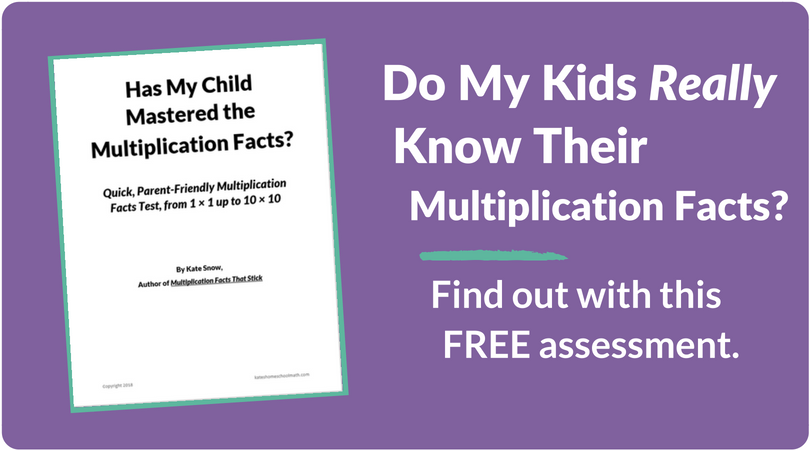what to do when students dont know multiplication chart
Larn a simple and efficient method for teaching your child the times tables. Plus, the #ane mistake parents make when teaching their kids the multiplication facts.
How Not to teach the times tables
In this article, you'll learn a stride-by-step program foreducational activityyour kids the multiplication facts.
But first, let's get direct on what Non to do.
For many people,memorizing the multiplication factsequalsrote practice. So, these wonderful, well-meaning parents figure that there's simply one way to assist their kids principal the multiplication facts: brand a big stack of flash cards and start drilling.
These parents want the best for their kids, but they're skipping a few steps…and they're making the whole process a whole lot more than painful and tedious than information technology needs to be. Practice and drill do help kids memorize the multiplication facts. But, they come at theceaseof the process, not theshowtime.
Psst…want an all-in-i, open-and-go resources for didactics the multiplication facts? I've put all these steps together into one book for helping your kids master the multiplication facts.

What are the multiplication facts (or times tables)? Why are they so important?
The multiplication facts (likewise known equally the times tables) are all of the multiplication problems from 1 × one = i up to 10 × 10 = 100.
- Related: Gratuitous Printable Multiplication Table (Blank and Completed)
Can y'all imagine trying to find common denominators or equivalent fractions without knowing 5 × vi? Or trying to do long sectionalisation when you're non quite certain what 7 × 7 is? And don't even get me started on factoring polynomials…

Without total mastery of the multiplication facts, kids struggle every bit they start to tackle division, fractions, and problems with larger numbers. They employ so much of their working retention on uncomplicated calculations that they have little encephalon infinite left for understanding new concepts.
In what course should my kids larn the multiplication facts?
Third grade. That style, they're well-prepared to tackle third- and fourth-grade math topics similar multi-digit multiplication, equivalent fractions, and division. Simply no matter what age your child is, learning the multiplication facts will make her much more confident and successful in math. If your older kid hasn't mastered the multiplication facts, information technology'south non as well late.

What do my children need to know before memorizing the multiplication facts?
Before memorizing the multiplication facts, your child should first learn the improver facts and subtraction facts. Each set of facts builds logically on the previous set, so it's important that your kid learn them in this order.
Before your kid begins memorizing the multiplication facts, you should first brand sure that she understands what multiplication means. (For example, that three × 8 means "3 groups of 8.") It also helps if she knows how to add 1-digit numbers to two-digit numbers mentally. (You'll learn more about why in Step 3 below.)
How fast should my kids know the multiplication facts?
Aim for no more than 3 seconds per fact, and faster if possible. But, it depends a lot on your child. Children who process information very quickly are quite capable of knowing each fact in less than ane 2nd, but children who are slower processors may e'er need a few seconds. You lot're the parent and know your child best, and then adjust your expectations to your individual child.
No matter how old your child, endeavor to go on exercise time relaxed and positive. Multiplication timed tests and drills aren't necessary unless your kid thrives on time pressure and finds information technology satisfying to beat the clock.
How to teach your kid the multiplication facts
Teaching comes before exercise
There'southward 5 steps to mastering the multiplication facts:
- Step 1: Break up the facts into manageable chunks.
- Stride ii: Make the facts physical with a simple visual.
- Pace 3: Teach your child to use easier facts every bit stepping stones to the harder facts.
- Step four: Practise each times tabular array on its own until information technology's mastered.
- Footstep v: Practice a mix of multiplication facts.
Notice how practice doesn't come until step 4? Practise is important, but information technology'south not where you start!Instruction comes before practice.
Stride 1: Pause it up.
This is a curt and easy footstep, but it'south important. Don't overwhelm your child with all 100 multiplication facts at one time. Instead, focus on just ane times table at a time. (A times table is merely i fix of multiplication facts. For case, the ×vi table is 1×vi, ii×6, 3×6, and and then on up to 10×6.)
Breaking up the multiplication facts makes mastering the tables feel much more than practise-able (for kids and parents). Plus, your kid can then use the easier facts as stepping-stones to the more hard facts.
Step ii: Brand the facts concrete with a multiplication assortment.
For each times table, first make sure your child understands concretely what the multiplication bug mean. Otherwise, the numbers are just sequences of abstruse symbols–and they're a lot harder to memorize.
In general, I'm a large fan of hands-on manipulatives for helping kids empathise math. But with multiplication, manipulatives can become pretty unwieldy. Information technology could take your whole math lesson just to count out vi groups of 8 objects–and your child probably wouldn't exist much closer to remembering that 6 × 8 equals 48.
Instead, I like to use a elementary grid of circles called a dot assortment. With a dot array, you can slide an L-shaped comprehend over the summit of the array and show whatsoever multiplication fact you want from ane×1 up to 10×10. Hither's what the dot array and Fifty-cover wait like.


Here's how you use them. For case, let's say we wanted to help your child sympathize what six × eight looks like. vi × eight ways "6 groups of 8," so slide the L-cover so that the dot array looks like this.

Each of the 6 rows has 8 dots, and then there are half-dozen groups of viii dots. So, the total number of dots in the array is the answer to six × 8.
- Related:Download your own printable multiplication array and L-cover.
How does visualizing the multiplication facts assist kids remember the answers? That'due south where Step 3 comes in.
Pace iii: Teach your child to utilize easier facts every bit stepping stones to the harder facts.
Multiplication is a bit similar climbing a huge pile of rocks. When y'all're trying to attain the top, it's a lot easier to climb up a few small rocks rather than attempt to scale a sheer rock face up.

With multiplication facts, it'south much easier to use facts you lot've already learned every bit "stepping stones" to the harder facts rather than to memorize them by rote. The dot array volition help your child do this!
For example, permit's go back to six × 8. It's 1 of the toughest facts for kids to memorize, only nigh children find it quite piece of cake when they use 5 × 8 as a stepping stone.
Here's how you teach your kid to use easier facts as a stepping stone to half-dozen × 8:
- 5 × eight is xl. (v × 8 makes a nice stepping stone, since children'south familiarity with 5s from their early years of arithmetic unremarkably make the ×5 facts easy to acquire.)
- 6 × viii is just one more group of eight than v × viii.
- And then, you tin simply add 40 + 8 to find the reply: 6 × 8 = 48.

This strategy works for all of the ×vi facts. And the good news is that there are like strategies for all the multiplication facts!
- Related: Multiplication Strategies That Will Help Your Child Primary the Times Tables
To utilize stepping stones, it's helpful if your kid knows how to add a ane-digit number to a 2-digit number mentally. If your child could use a piddling more practise with mental addition, I've put together a short lesson and game that will help him castor up on this skill.
- Related: The Mental Addition Game That'due south Really a Multiplication Game
With this combination of the dot array and stepping-rock facts, your child has a game plan for mastering all the multiplication facts for good. (Without having to memorize each fact individually.) Now, all you need are some constructive practice techniques to help your child become fully automated with all the multiplication facts.
Stride 4: Practise each times table on its own until it's mastered.
Once your child has learned how to use stepping-stone facts for a times tabular array, focus on only that specific times table for several days. Use a mix of practise techniques to give your child some variety and brand learning multiplication fun. I like using a mix of recitation, games, and worksheets, so that kids speak, see, and write the facts.
Recitation
I know, reciting the times tables may seem old-fashioned. Simply, saying data aloud helps to cement it in your kid's memory. Plus, reciting each table in order helps your child sympathise how the facts in the table are related. For example, reciting "ane × seven is vii. 2 × vii is fourteen. 3 × seven is 21…" reminds your child that each new fact in the ×seven table is vii more than the previous fact. So, she can add 7 to each previous fact to assist her recollect the side by side 1, considering the facts in the table add a new grouping of 7 each time.
Games
I heart math games! They make math fun and social, but they also have a huge teaching do good: when yous play a multiplication game with your child, yous can monitor how well your kid is using the strategies–and fix any mistakes before they become ingrained.
Worksheets
Worksheets aren't the most exciting, but they're an important practice component, since your kid will often use multiplication in his written piece of work. Keep worksheets short and sweet so that your kid stays warning and focused.
Step 5: Mix those multiplication facts with other times tables.
Once your child has mastered the new times tabular array, it'southward time to mix up those multiplication facts with the facts she's already mastered. Mixing them together provides cumulative review so that the facts are cemented in her long-term memory. Continue using recitation, games, and worksheets (and even flash cards, if y'all desire) until your child has all 100 facts memorized.
- Related: 3 Fun (and Costless!) Printable Multiplication Facts Gamesfor practicing mixed multiplication facts
Teach Multiplication Facts That STICK
So, that's all five steps! You're now well-equipped toteachyour child the multiplication facts (and not just drill stacks of flash cards.)
You lot could spend hours planning out lessons, making up your own worksheets, and scouring Pinterest for beautiful multiplication games. (And hey, if you like doing that kind of matter, get for it!) Merely, if you lot have other things to do, I've already done the work for you.
Multiplication Facts That Stickis an open-and-get, all-in-one book for pedagogy your child the multiplication facts. It gives y'all detailed lesson plans, fun games, and simple worksheets for every step of the procedure, and then that you can teach your child multiplication facts that trulystick.
cartwrightarage1945.blogspot.com
Source: https://kateshomeschoolmath.com/multiplication-facts-that-stick/
0 Response to "what to do when students dont know multiplication chart"
Postar um comentário